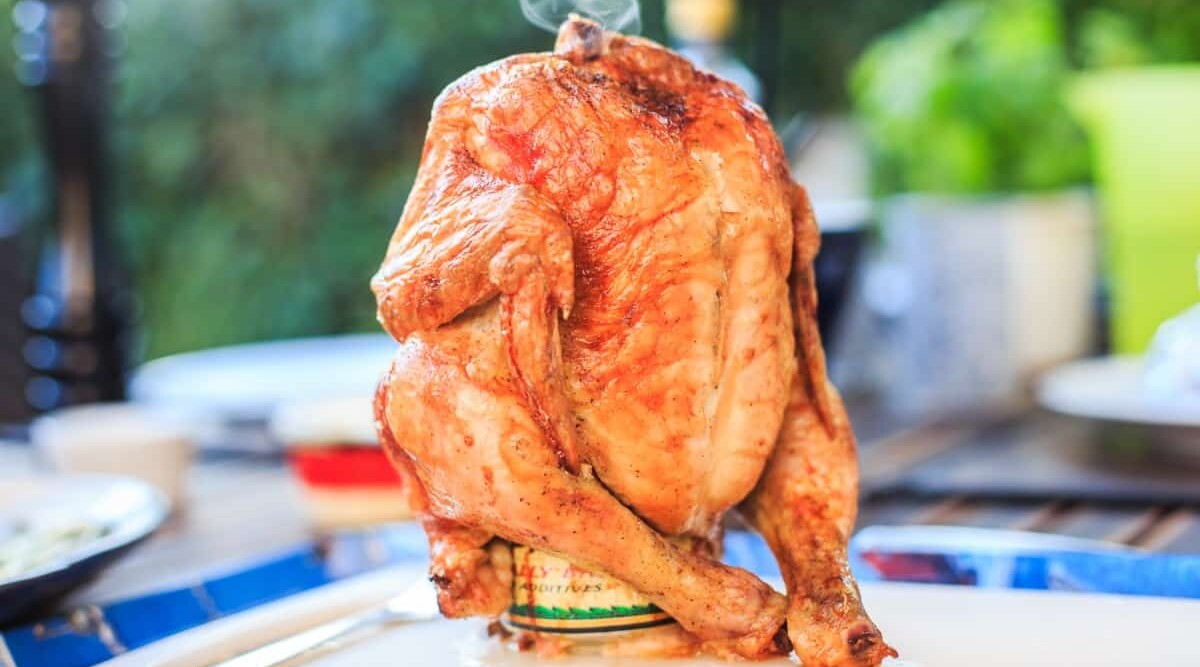
As noted in our myth busting article, beer can chicken is one of those food prep methods that everyone knows but very few have proven to add any flavor, crispness, or tenderness to a chicken.
It came out of the mists of time, now a well-established tradition. A visual funny married with an awesome taste. Because someone, somewhere, at some point in time, said it was.
Most of its merits are unproven, but there are some good reasons to try something like this cooking method.
Its origin unknown, we’ll dive right in and discuss why beer can chicken deserves a place on a list of BBQ myths, get our science on with temperatures and gases, cover some very real dangers, and the good things about this technique.
We’ll finish with a mini product overview and a couple of beer can chicken recipes — with a twist.
Oh, and from here on in, we’ll say BCC for beer can chicken.
Jump to:
- 1 What’s Good About Beer Can Chicken
- 2 What’s Bad About Beer Can Chicken
- 3 Temperature and Steam
- 4 Smelling Isn’t Tasting
- 5 A Whisper of Flavor
- 6 Food Poisoning and Other Potential Hazards
- 7 Avoiding First Aid
- 8 Can Millions of Fans be Wrong?
- 9 Vertical Cooking — Same Concept, Better Results
- 10 Vertical Chicken Holders — Better than a Beer Can
- 11 Vertical Chicken Recipe
- 12 The Conclusion of the Matter (Maybe)
What’s Good About Beer Can Chicken
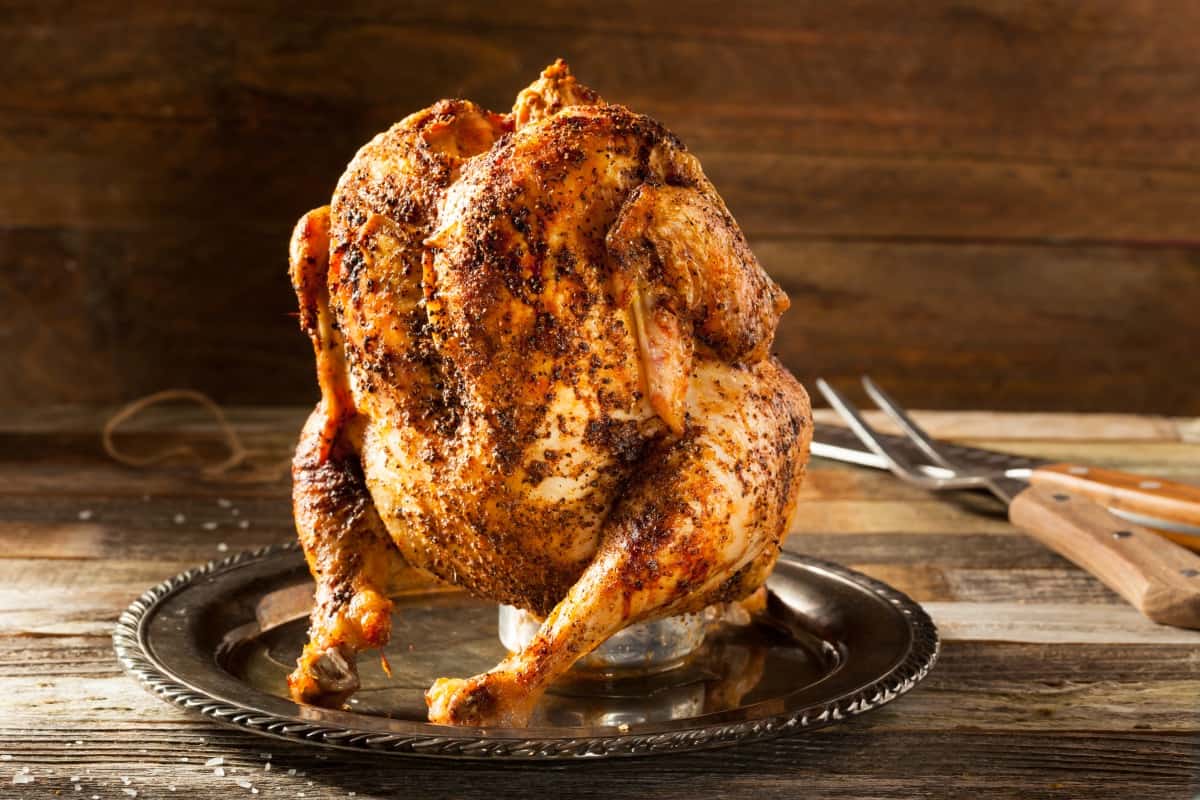
Very little. But those few good things are very good:
- Crispy skin with a nice crunch
- Even browning
- Dark meat and white cook to their respective and different doneness temps (170-180° and 160 °F, respectively) at the same time.
What’s Bad About Beer Can Chicken
So much is bad about this method, as in food poisoning risk bad. Here’s why:
Cool to the Core
Dr. Blonder, AmazingRib’s science guy, weighed in on the temperatures and safety concerns of BCC.
Measurements found the beer can make the interior of the bird 47 degrees cooler than an empty cavity chicken after an hour in the oven. The temperature difference was a little less on a gas grill, but not enough to matter.
Also, the interior never reached the boiling point which would generate the steam necessary for infusing flavor into the meat.
Can This Be Good for You?
I brought this up in our BBQ myth article, but it bears repeating. Tommy Simmons, a writer for AP Weekly features, asked a USDA food safety expert whether it was safe to cook a chicken on a beer can. That was in 2002 when hardly anyone had even heard of such a thing. Not surprising were the answers received:
- Beer can exteriors had not been tested for such use and so were not approved for food contact
- Inks used for the labels were not tested for toxicity or carcinogenity when heated
- The can was tested for safety as a beverage holder, not a cooking utensil
- The expert couldn’t say there was not a risk of harmful chemicals leeching into the meat
By contrast, grill-meister Steven Raichlen, who wrote a book on the subject, told Simmons that edible inks were applied to a can at more than 500 °F but in the BCC method the can doesn’t get hotter than 212 °F.
With all due respect to Meister Raichlen, that wouldn’t satisfy me unless, at the least, their research considered
- The effect of prolonged heat (can a little heat over a long time be worse than a lot of heat for a brief time?), and
- The possibility of an emulsifier (chicken fat) changing the composition of the heated ink or the material — aluminum — of the can.
You Know Those Little Widgets in the Guinness Cans?
They contain nitrogen with a little beer mixed in. When the can is opened, the falling pressure inside the can causes the nitrogen to rush out of the widget and mix with the carbon dioxide from the fermenting process to create a beautiful creamy head when the beer is poured into a glass.
A fine thing if you want to admire a pub-worthy looking beer and enjoy a “sweeter, silkier experience” as Guinness describes it. But would it give the chicken a silky, sweet flavor? Would you really want a silky tasting chicken? And what happens to the widget when it’s heated?
What about the nitrogen? Nitrogenization makes bubbly drinks bubblier and is often used for that purpose. It is a very inert gas, meaning it doesn’t change form. So even heated, it shouldn’t create a problem, right? Too many unanswered questions here.
Temperature and Steam
The numbers just don’t add up here. Meathead Goldwyn seems to be the most vocal BCC myth destroyer around. In a short video, he explains about cozies, temperatures, and the better way to roast a chicken.
Water boils at 212 °F, alcohol at 170 °F. Chicken is done at 165 °F which means it should come off the heat at 160 °F to finish by carryover cooking. For there to be steam, the liquid must reach boiling point. The beer can’t reach boiling point because it’s insulated — by the chicken.
Remember that meats cook from the outside in. The cavity of the chicken is going to be cooler — and stay cooler than the outside. By the time your chicken has reached eating temp, almost nothing from the can will have evaporated, it just does not get hot enough, so it cannot in any way possibly flavor the meat. Making the whole exercise futile.
In the event you do manage to get the beer to boil, it will be steaming up through a seriously charred remnant of a chicken.
Smelling Isn’t Tasting
Don’t stop at beer, BCC fans say. Use herbs, use wine, they say. Get a strong enough beer, they say. The flavor will permeate the chicken from the inside out, they say.
But, no steam, no permeating flavor, says the science. Michael Chu of Cooking for Engineers notes those nice smelling aromas so noticeable when food is cooking are volatile compounds which are quick to dissipate into the air. Too little time to make a big impact on the food.
Wine, beer, juice — I didn’t taste what my nose told me to expect. All the BCC experiments did yield a smidgen of flavor, but only around the neck, the area closest to the opening of the beer can.
A Whisper of Flavor
Scott Bruslind of Analysis Laboratory gives another explanation as to why so little beer flavor comes through in the BCC method. The percentage of flavor compounds in beer is outmatched by the percentage of water, alcohol, and carbon dioxide. This ratio works out to about a teaspoon of flavor to a 12 ounce can of even the darkest stout.
| Ave. % by weight in 12 oz. Can | |
|---|---|
| Carbon dioxide | 0.25% |
| Flavor | 3.5% |
| Alcohol | 4.25% |
| Water | 92.0% |
Food Poisoning and Other Potential Hazards
It can’t be stated enough how serious a health hazard undercooked poultry can be. The USDA states 165 °F should be the temperature throughout the chicken, not just the surface. Remember Meathead’s tea cozy comparison. Fat insulates, right? What’s under chicken skin? Uh huh.
If the outside temp is just 165°, you’re serving semi-raw chicken near the bone. You may also be serving Salmonella Enteritidis, Staphylococcus aureus, Campylobacter jejuni, or Listeria monocytogenes.
These bacteria cause gut upset with symptoms starting as late as 5 days after eating infected foods. Symptoms may last a week or more. And they have the potential for creating severe infections which can kill you, warns the USDA.
For years, health gurus have claimed research links use of aluminum with Alzheimer’s disease. As recently as 2016, researchers at the University of Lille, France, have linked diseases of the gut with ingestion of aluminum. Although the impact of aluminum on health hasn’t been well documented, it also has yet to be proven untrue. Beer cans are made of aluminum. Make of that what you will.
Avoiding First Aid
Consider how comfortable you would be handling a hot aluminum can, greasy with melted fat, and filled with scalding hot liquid? How long would you have to wait to remove the can?
There is a very real need for cautious handling of a BCC hot off the grill.
Can Millions of Fans be Wrong?
Yes. Yes, they can. Because despite the number of posts, books, vids, and articles waxing poetic on the moist, tender, beer flavor, there’s no science to support these claims.
If a blind taste were done, would you really be able to tell which chicken had a beer? Some insistently say YES. But…
Kenji López-Alt of Serious Eats did a blind taste test using three chickens. Into the cavity of one went a beer can half filled with beer; into the second, a beer can filled with enough dried beans to match the weight of the beer in the first; and into the third, a can of Lipton tea.
Volunteering one of his interns, each of the chickens was sampled without knowing which was which. The flavor, texture, and weight were the same for all three samples.
Of course, Meathead did a taste test too. He had the same results as Kenji’s, with the added experience of finding that the fat dripping into the can neatly sealed in the beer. No path to beer steam infusing anything there. And the fat-in beer can weighed nearly an ounce more after cooking.
So what’s a beer-lovin’, crispy-skin chicken fan to do? How to get the good things about BCC while avoiding the bad? You have options.
Vertical Cooking — Same Concept, Better Results
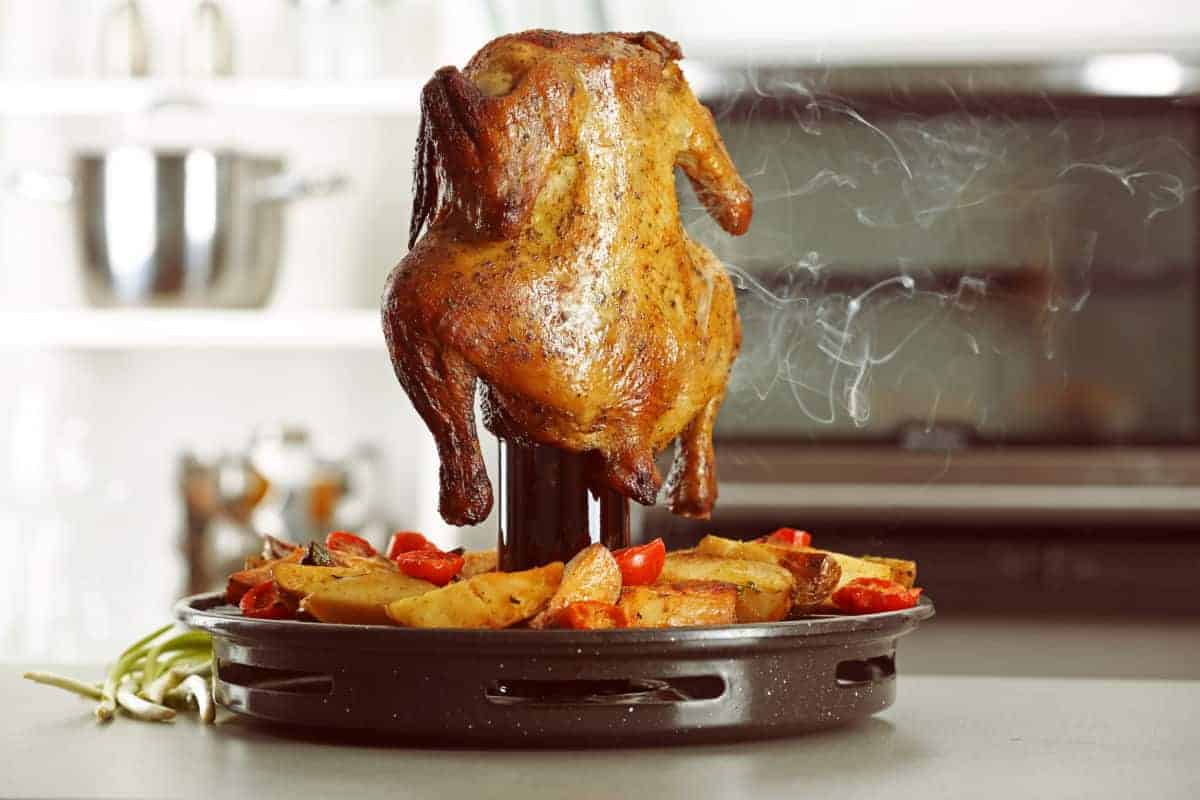
If you want beer-flavored chicken, marinate it, or use an injection recipe perfect for poultry.
A crispy skin can be had by grilling the chicken until the outside reaches 185 °F. This brings its own hazard as it can be easy to overshoot the ideal temperature and the crispy turns burnt-to-a-crisp. So you’re better off implementing one or more of the tips discussed in our guide on how to get crispy chicken skin.
Here is the best feature of BCC: cooking it vertically instead of horizontally.
One problem with cooking chicken is that the dark meat, having more fat, cooks slower than the white meat. Workarounds for this usually involve wrapping the faster cooking portion in foil to prevent it from burning while the other half catches up. But with vertical cooking, the thighs and drums, being closer to the heat source, get the needed extra time without overcooking the faster cooking breast and wings.
How to get the chicken to sit without an airflow-blocking can in its cavity? A whole new line of cooking gadgets to hold the bird upright while allowing air flow through and around it. Blonder’s experiment also found the interior of a chicken cooked on a vertical holder was some 50 degrees hotter than the beer can holder.
You may be able to get away with using a beer can holder without the beer can to eliminate the problem of blocked air flow. Or try one of the many steel or ceramic vertical holders which are at home in the oven or on the grill. A few of these aluminum can-free models:
Vertical Chicken Holders — Better than a Beer Can
Norpro Deluxe Stainless Steel Vertical Chicken Roaster

Shallow round drip pan sprouts two wires that rise to cross each other at an angle.
- Stainless steel
- 4” x 4.4” x 6”
- 1 pound
- 8 pounds is the maximum weight the roaster can hold, states the manufacturer
- Based on user comments, it can be used in indoors in the oven, NuWave cooker, and outdoors in a smoker or on a grill.
- Wires fold down for storage
- Handwashing is recommended, although some owners put it through the dishwasher
Norpro Stainless Steel Vertical Roaster, With Infuser

Cone-shaped stainless steel infuser sits atop stainless steel cup which holds up to 10 ounces of liquid. A wire frame holds infuser and cup together. All rest over a round dish.
- Stainless steel
- 5” x 5.5” x 5.5”
- 1 pound
- Holds up to an 8-pound chicken
- Handwashing recommended
- Assembly instructions only
- Some owners are happy using it indoors, others feel it’s better suited to a grill with lots of overhead space
Sittin’ Chicken Marinade Barbecue Steamer

Glazed ceramic beaker has a hollow cavity for beer, alcohol, sauce, fruits, vegetables
- 1” x 5.1” x 4.6”
- 4 ounces
- Wide opening at the top along with 4 steam ports along the lip
- Use on the grill or in conventional oven
- “Free from heat producing toxins”
- Dishwasher Safe
- Recipes included
- One owner reports using it for a 15-pound turkey, although the seller cautions not going above 10 lbs. for a chicken. There is a larger model available for turkeys.
- Other owners assure that the colorful logo is safely glazed over.
Big Green Egg Vertical, Stainless Steel Chicken Roaster

A simple design of a 5-point stainless steel tower rising from a 6-inch round base. Allows air to freely flow inside and outside the chicken. (Its larger cousin stands on a 7” base for vertical roasting of turkeys.)
- Chrome plated steel construction
- 4” x 5.4” x 7.8”
- 6 ounces
- 10” tall
- Works with XXLarge, XLarge, Large, Medium, and Small Eggs
Which Would We Choose?
Among this short list, we would opt for the convoluted Norpro infuser model since it also gives the option of adding herbs, not just liquids.
Beware products like the Emile Henry Chicken Roaster.
Handcrafted from Burgundian red clay, it features a solid spire to set the chicken on. Like the beer can holder models, there is no flow of hot air through the cavity. Some owners note the deep dish holds liquid for vegetables so well, the skin doesn’t crisp.
Vertical Chicken Recipe
Either the Norpro or Sittin’ Chicken would work for a slightly modified version of AllRecipes’ Beer Lime Grilled Chicken. Now there’s a recipe worthy of beer, grills, and chickens. A trifecta!
For classic barbecue flavor, try this Grilled Whole Chicken with Sweet BBQ Sauce from EatingWell.com
It uses a smoked chicken rub consisting of:
- Chili powder
- Salt
- Brown sugar
- Ground cumin
- Smoked Paprika
- Garlic Powder
- Ground Ginger
- Cayenne Pepper
The rub can be made up to a month in advance and kept in an airtight container.
It takes about 15 mins of prep time, and 1.5 hours of cooking time, with the chicken being done when the interior temperature reads 175 °F, as measured with an instant read thermometer. And if you don’t have one, check out our search for the best instant read thermometer where we review the top models available today.
For a list of ingredients with quantities, and instructions to follow, please visit the original recipe here: EatingWell.com Chicken with sweet BBQ sauce recipe.
We would also recommend ramping up the flavor with the addition of some smoke. Try adding a chunk or two of the woods for smoking chicken from our guide.
You’ll also find plenty of other recipes online, enjoy the experiment!
The Conclusion of the Matter (Maybe)
From the scientific perspective, beer can chicken is a miss. It’s the placebo of the grilling/cooking world; people taste in the bird a particular flavor primarily because they expect to taste it there.
BCC has captured the fancy of millions who aren’t shy about voicing their endorsement of this entertaining cooking method. But the safety concerns are real; so is the risk of having an unevenly cooked chicken.
By contrast, vertical holders bring the best of BCC while guaranteeing even, thorough cooking and a crispy skin. So open a beer, and empty it down the hatch or into a bowl for a marinade or injection.
And there are always recipes like this Beer Potato Salad, a perfect accompaniment to your grilled meat.
Ready to take the vertical holder versus beer can holder challenge?


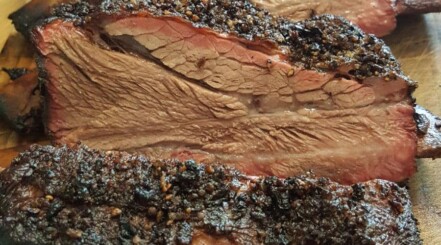
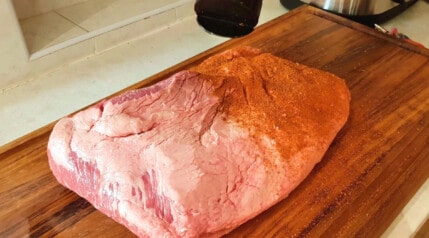
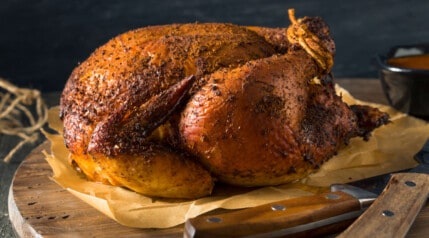
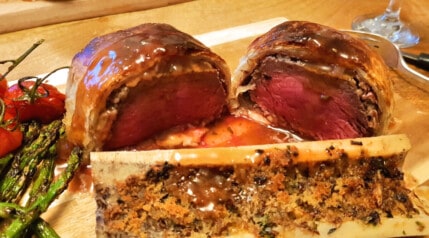
Very informative. It changed my way of thinking. Thank you!
Thanks, Toby.
I had the same concerns long ago about heating aluminum and the exterior paint of a beer can when I first tried the beer can chicken. Then I found the Weber BCC tray, has a nice large four prong spreader that opens the chicken to get the hot air flow and a cup to hold the beer or whatever liquid you want, and like the others noted in the article it has a tray to catch the chicken drippings keeping it from going into my grill. I personally think having a liquid, whatever it may be beer, wine or anything else does keep the chicken moist at least. Does it impart a flavor? Don’t know but will continue to go with it. Happy grilling.
Author doesn’t seem to understand how a gas or charcoal grill works and that the can is sitting on a steel grate that is approximately 800 degrees when you set the can on it. Yes the beer boils, author seems to think chicken is made of some super insulating compound, why on earth would the chicken be undercooked? The cavity is going to be at least as hot as the grill temp, based on the fact that it’s gaping open over a hot can of vapor. I’ll agree that the can probably leaches chemicals from the paint on the can and there are some alternative products that you can pour beer into for a beer can chicken, in fact some were recommended here. Flavor is subjective. I could tell you that beer can chicken tastes like rainbows, and I’d be right. It does make a perfectly cooked chicken by vertical cooking, and if you rubbed it right and took it off at 165 on the nose it’ll be juicy and tender. Also, trying to make pulling a hot can out of a chicken is petty and moot, as you lift the chicken off the can. Gravity removes the can. You come back later when it’s all cool and dump the chicken fat and 3 oz of beer out. That’s right 3 oz, because the other 5 oz boiled out, into the chicken. 🙄
I can only suggest you re-read the article, the links throughout the article to the experiments others have done and documented, and then cook some chickens this way yourself, while weighing the beer can before and after, and taking the temperature of the beer right after cooking. I’ve done so, and can confirm what’s presented here. Do the same and let us know the results.
I want my chicken evenly cooked. The beer and beer can interferes with that. It’s simply a bad approach. Live with it.
Interesting. I had no idea there was any debate about this topic! I’m new to the beer can method–I recently got a Traeger and tried it for the first time a month or two ago. I’ve now done it a handful of times. The beer in the can definitely boils–cooking at 350ish, it periodically drips and sometimes even streams out of the drip tray into the bucket, and I can hear it bubbling as it boils. When I remove the chicken, the can is around half full. I’ve tried both beer and hard cider, and the taste is noticably different between two, each tasting a bit like whichever liquid I use. I don’t doubt the issues about possible chemicals or that there are better ways to cook a chicken, but in my short time trying this method out, it’s been really tasty and effective. I don’t know if a pellet smoker would affect a can of liquid differently than any other method, haven’t tried it on my propane grill yet. Obviously this is purely anecdotal, but in my experience it absolutely boils and does impart flavor specific to the beer/cider I’ve used. Not saying any of this is article is wrong, and this led me to other articles that agree it’s bogus… Yet for whatever reason, it doesn’t line up with my own experience. Interesting indeed…
Thank you for your help in debunking BCC. It’s inferior and only supported by those blindly thinking beer is the answer to cooking almost anything.
Haha…it solves a lot of other problems though!